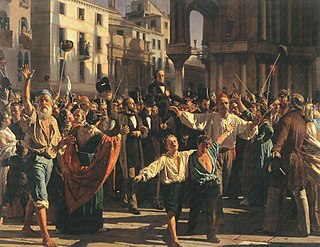Related Research Articles

Telemaco Signorini was an Italian artist who belonged to the group known as the Macchiaioli.

Vincenzo Irolli was an Italian painter.

Plinio Nomellini (1866–1943) was an Italian painter.
Angelo Baccalario was an Italian painter of landscapes, mainly in the Piedmont.
Eugenio Tano was an Italian painter.

Angiolo Torchi was an Italian painter, mainly of landscapes. He is also known as Angelo Torchi under which Wikipedia has articles in Italian and French.
Riccardo Pasquini was an Italian painter.

Napoleone Nani (1841–1899) was an Italian painter, active in Venice, where he became professor of the Accademia di Belle Arti.

Pietro Scoppetta or Scappetta was an Italian painter, painting in an Impressionist style using both oil and pastels.

Alfredo Luxoro (1859–1918) was an Italian painter, mainly of landscapes, genre, and orientalist themes.
Alberto Melillo was an Italian painter.
Domenico Pesenti was an Italian painter and antiquarian. He painted mainly vedute.
Raffaele Armando Califano Mundo was an Italian painter.
Luigi Papafava (1838–1908) was an Italian painter and engraver.

Camillo Miola, also known as Biacca, was an Italian painter, often painting exotic Neo-Pompeian and Orientalist subjects. He also painted history and portraits.

Alberto Pisa was an Italian painter, often painting ruins, landscapes, and garden views in bright watercolor.
Luigi Lanza was an Italian painter, depicting mainly vedute, in oil and watercolors.

Antonio Piccinni was an Italian painter, mainly of watercolors. He was also an engraver, facile in the engraving of diverse subjects, from history, landscape, portrait, and sacred subjects.
Gioacchino Gamberini was an Italian painter noted for genre painting as well as city and rural views.
Arturo Conterno was an Italian painter, active mainly in Turin.
References
- ↑ Augusta Taurinorum: Torino Illustrata nelle sue cose e nei sui cittadini [ permanent dead link ]. Editor Ernesto Marini, Genoa, (1901) page 213-214.
- ↑ Dizionario degli Artisti Italiani Viventi: pittori, scultori, e Architetti., by Angelo de Gubernatis. Tipe dei Successori Le Monnier, 1889, page 364.